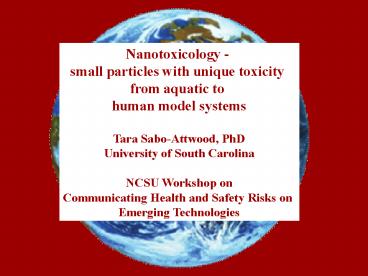Nanotoxicology - PowerPoint PPT Presentation
1 / 22
Title:
Nanotoxicology
Description:
Nanotoxicology – PowerPoint PPT presentation
Number of Views:3213
Avg rating:3.0/5.0
Title: Nanotoxicology
1
Nanotoxicology - small particles with unique
toxicity from aquatic to human model
systems Tara Sabo-Attwood, PhD University of
South Carolina NCSU Workshop on Communicating
Health and Safety Risks on Emerging Technologies
2
Todays talk (from an environmental molecular
toxicologist point of view)
- Nanomaterials in the environment challenges of
assessing - unintended exposures
- Influence of public perception on science
- What have we learned? Unexpected effects
3
Nanomaterials Represent a Novel Form of
Contaminants in the Environment
Not a question of IF but WHEN WHAT
4
Challenges of assessing environmental exposures
Complex webs and networks
5
If nanoparticle X moves from consumer product
to soil to groundwater
countless scenarios of how these particles could
impact drinking water
6
How to study safety of nanomaterials?
Nature 444, 267-269 (16 November 2006), Safe
handling of nanotechnology Andrew D. Maynard et
al.
Communicating research on nanotechnology risks
and benefits outside the scientific community is
challenging, but is essential for a risk dialogue
based on sound science. This means developing
communication activities that enable technical
information to be summarized, critiqued and
ultimately synthesized for various interested
parties, including decision-makers and consumers.
The advent of the Internet provides an ideal
venue for such activities and we encourage its
use in communicating with the end-users of
risk-based science.
Public perceptions are not static
7
Fundamental Knowledge of the Environmental
Impacts of Nanomaterials
Effects of Environment and Living Systems on
Nanomaterials Fate and Transport Aggregation Surf
ace Change Adsorption Partitioning Compartment
Modeling
Effects of Nanomaterials on the Environment and
Living Systems Bioaccumulation Biomagnification
Biodiversity Metabolism, Reproduction Quality of
Life Food Web Modeling
Nanomaterial Production, Standard Reference
Materials, Analytical Methods to detect
Nanomaterials in the Environment and Living
Systems
RISK ASSESSMENT
8
Public influences risk management and
toxicological science
Public
toxicological science (which particles,
fate, transport, route etc)
Risk assessment/management
9
Lung epithelial cells exposed to SWNT
A number of genes altered are involved in cell
cycle regulation and mitochondrial/electron trans
port function Some are similar to gene changes
observed with asbestos
Electron transport genes altered 27 Cell cycle
genes altered 32 of genes altered by
asbestos 55
10
Which nanoparticles are toxic and which are not?
If so, what inherent properties govern
toxicity? Challenge not all scientists
agree (impact trust, perceived benefit
etc) What have we learned so far?
- Are gold nanoparticles biologically inert?
Plants and - human cells exposed to gold nanoparticles
- toxicity of synthesis byproducts - marine
invertebrates - (copepods) and human cells exposed to SWNT
- Subtle unusual effects - freshwater fish
(medaka) - exposed to silver nanospheres
11
Gold nanoparticles - biologically inert?
Tobacco seedlings were exposed to gold
nanospheres (3.5 or 18 nm)
3.5 nm spheres were taken up via roots and
distributed throughout plant
12
Gold nanoparticles - biologically inert?
Mechanisms of toxicity gene profiling
- Tomato plants exposed to 3.5 nm gold spheres for
5 days. Microarrays performed on leaves and
roots. - Results Leaves with at least 2-fold change in
expression between control and exposed - Roots with at least 2-fold change
- Common genes to leaves and roots
Leaves
But no metallothionein, wound or pathogen
response genes
734
96
28
Roots
13
Gold nanoparticles - biologically inert?
AR1
AR2.1
AR2.6
AR2.9
AR3.4
AR4.1
safe particles by design?
14
What about particle synthesis byproducts?
- SWNTs
- Electrophoretic Purification (Xu et al., 2004)
- Purified SWNTs nominal molecular weight (NMW)
gt100K - Short tubular nanocarbon NMW 50K 100K
- Fluorescent Nanocarbon NMW 12.5K 50K
15
What about particle synthesis byproducts?
Effects of SWNT on copepod nauplius adult
development
AP-SWNT
Pure SWNT
Fluorescent nanocarbon
16
Do new materials influence toxicity ofold
materials
10 mg L-1 SWNT in 10 mM phosphate
buffer/synthetic seawater solution (pH 7.8)
Napthalene
0 ppt
25 ppt
17
Bioavailability factors for PCBs and PBDEs
Error bars represents 1 sd. Significant
differences relative to HOC only treatment are
denoted with an
18
Unusual effects
Freshwater fish (Medaka) exposed to silver
nanospheres
- Fish embryos were exposed in water to 10 ppm
silver-colloid nanoparticles - (4 nm diameter, commercially available)
- After 5 hours, the embryo architecture is
completely destroyed - Environmental concentrations will likely be
50-1000 times lower.
19
(No Transcript)
20
What does all this mean (as toxicologists)? Our
understanding of the potential toxic effects of
nanomaterials is more complex than originally
thought Daunting challenge so may
nanomaterials, byproducts etc classic
toxicological paradigms need to shift to a more
interdisciplinary approach including modeling and
forcasting But how do we do this? How will this
effect risk communication?
21
Risk Communication
Risk Communication
Risk Assessment
Risk Management
Regulatory Process
Risk Characterization
Regulatory Decision
REGULATIONS
SCIENCE
informing the public and involving them in the
risk assessment and risk management processes.
Adapted from http//www.envirotools.org/presentati
ons/ppt_riskcommunication.htm
22
Acknowledgements
Nanoenvironmental Team
Research Triangle Institute (RTI) and Dr. Wally
Scrivens (USC Dept. of Chemistry) 14C-SWNT
synthesis collaboration Funding EPA STAR, NSF,
USC research foundation
Tom Chandler
Alan Decho































